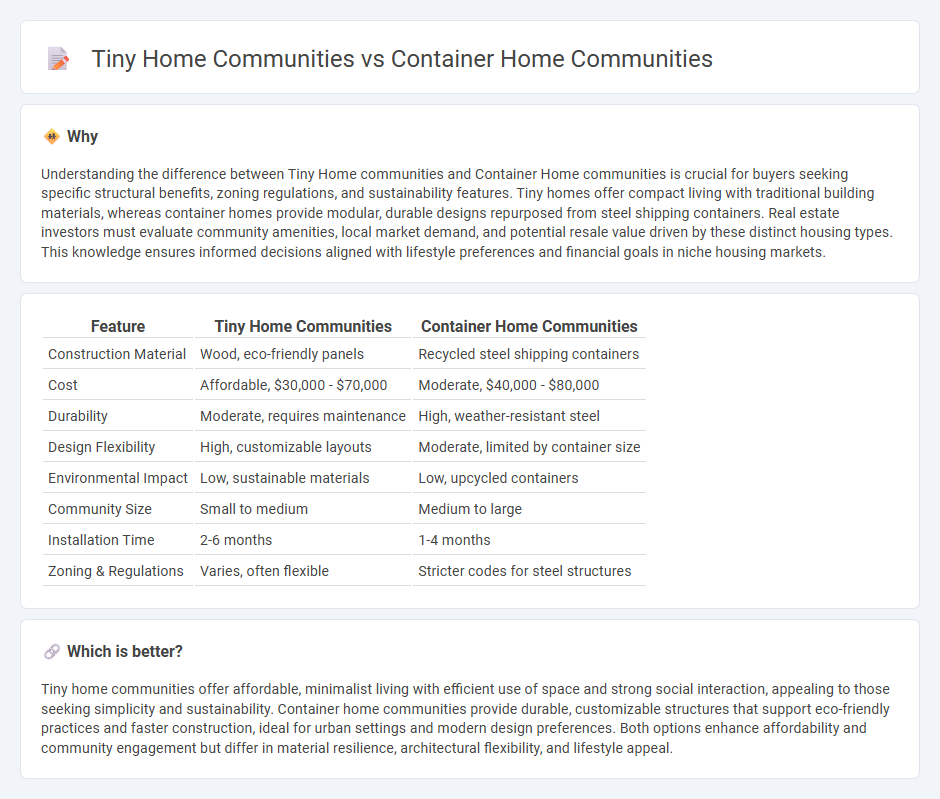
Tiny home communities offer compact, energy-efficient living spaces optimized for affordability and minimal environmental impact, often situated in scenic or urban-adjacent areas. Container home communities utilize repurposed shipping containers, providing durable, modular structures with customizable layouts that emphasize sustainability and rapid construction. Explore the unique benefits and challenges of both to discover which innovative housing solution suits your lifestyle.
Why it is important
Understanding the difference between Tiny Home communities and Container Home communities is crucial for buyers seeking specific structural benefits, zoning regulations, and sustainability features. Tiny homes offer compact living with traditional building materials, whereas container homes provide modular, durable designs repurposed from steel shipping containers. Real estate investors must evaluate community amenities, local market demand, and potential resale value driven by these distinct housing types. This knowledge ensures informed decisions aligned with lifestyle preferences and financial goals in niche housing markets.
Comparison Table
| Feature | Tiny Home Communities | Container Home Communities |
|---|---|---|
| Construction Material | Wood, eco-friendly panels | Recycled steel shipping containers |
| Cost | Affordable, $30,000 - $70,000 | Moderate, $40,000 - $80,000 |
| Durability | Moderate, requires maintenance | High, weather-resistant steel |
| Design Flexibility | High, customizable layouts | Moderate, limited by container size |
| Environmental Impact | Low, sustainable materials | Low, upcycled containers |
| Community Size | Small to medium | Medium to large |
| Installation Time | 2-6 months | 1-4 months |
| Zoning & Regulations | Varies, often flexible | Stricter codes for steel structures |
Which is better?
Tiny home communities offer affordable, minimalist living with efficient use of space and strong social interaction, appealing to those seeking simplicity and sustainability. Container home communities provide durable, customizable structures that support eco-friendly practices and faster construction, ideal for urban settings and modern design preferences. Both options enhance affordability and community engagement but differ in material resilience, architectural flexibility, and lifestyle appeal.
Connection
Tiny home communities and container home communities are both innovative solutions in the real estate market addressing affordable and sustainable living. These communities utilize compact, efficiently designed spaces to maximize land use and reduce environmental impact, appealing to urban planners and eco-conscious buyers alike. Shared amenities and communal layouts in both types foster strong social connections while optimizing real estate investments in high-demand areas.
Key Terms
Zoning Regulations
Zoning regulations often determine the feasibility of container home communities versus tiny home communities, with many areas categorizing container homes similarly to traditional modular buildings and permitting them under commercial or industrial zones. Tiny home communities frequently face stricter residential zoning restrictions, including minimum size requirements and utility hookups, impacting their development potential. Explore detailed zoning codes and compliance strategies to better understand how these regulations affect community planning.
Infrastructure Requirements
Container home communities require robust infrastructure including reinforced foundations, advanced HVAC systems, and specialized waste management to support durable steel structures. Tiny home communities typically demand more flexible utility setups and less intensive foundation work due to smaller, lighter dwellings. Explore detailed comparisons on infrastructure needs to optimize community planning.
Scalability
Container home communities offer superior scalability due to standardized, modular units that can be stacked and arranged efficiently on limited land, enabling rapid expansion. Tiny home communities, while flexible in design, often face challenges in scaling because of diverse architectural styles and zoning restrictions limiting density. Explore detailed comparisons to understand which community type best supports your growth objectives.
Source and External Links
Shipping Container Home Community - This blog discusses real-life examples of shipping container home communities, such as "The Melody" in Atlanta and a similar project in Denver, which provide stable housing alternatives for homeless individuals.
Shipping Container Village - This project is part of One Community's initiative to create sustainable, semi-subterranean living options using shipping containers, offering 36 living units and various common spaces.
Tiny Shipping Container Home Village - This community features four unique 20ft shipping container homes, offering a compact and innovative living space with distinct features.
 dowidth.com
dowidth.com